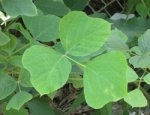Kudzu Vine
Pueraria montana
Kudzu is a perennial legume that originates from Japan. It was brought to the United States in 1876 for the Worlds Fair. In the 1900 it was used as a forage for cows, pigs and goats and later as cover for erosion control.
Known as "the vine that ate the south" Kudzu Vines can grow a foot a day and covers everything in its path. It's able to pull down power poles, break power lines, collapse buildings and kill trees.
Today the range of Kudzu in the U.S. extends from Connecticut to Missouri, Oklahoma, Texas and Florida. It has also now been found in Leamington, Ontario which is 30 km southeast of Windsor, overlooking Lake Erie.
Kudzu grows best in rough well drained eroded land 
Informations provided by the Missouri Department of Conservation
Resources
2011 Rural Municipality Distribution Map
2010 Rural Municipality Distribution Map
Â
Back to Terrestrial Invasive Species List
Â
© Copyright 2004-2025 - CMS Made Simple
This site is powered by CMS Made Simple version 1.4.1


